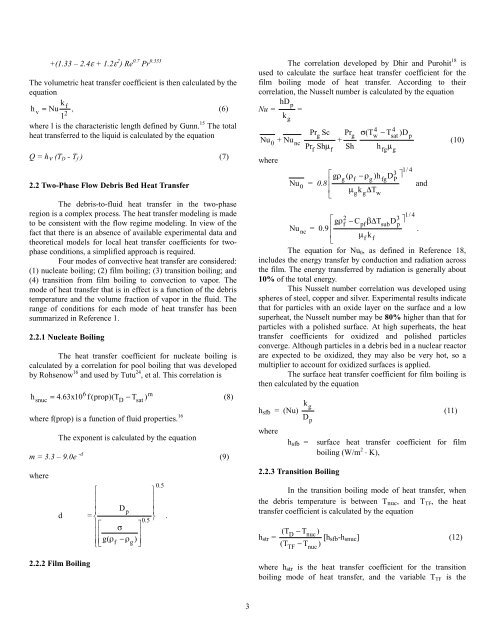SCDAP/RELAP5 Modeling of Fluid Heat Transfer and Flow Losses ...
SCDAP/RELAP5 Modeling of Fluid Heat Transfer and Flow Losses ...
SCDAP/RELAP5 Modeling of Fluid Heat Transfer and Flow Losses ...
Create successful ePaper yourself
Turn your PDF publications into a flip-book with our unique Google optimized e-Paper software.
+(1.33 – 2.4ε + 1.2ε 2 ) Re 0.7 Pr 0.333<br />
The volumetric heat transfer coefficient is then calculated by the<br />
equation<br />
k<br />
h f<br />
v<br />
= Nu , (6)<br />
l2<br />
where l is the characteristic length defined by Gunn. 15 The total<br />
heat transferred to the liquid is calculated by the equation<br />
Q = h ν (T D - T f ) (7)<br />
2.2 Two-Phase <strong>Flow</strong> Debris Bed <strong>Heat</strong> <strong>Transfer</strong><br />
The debris-to-fluid heat transfer in the two-phase<br />
region is a complex process. The heat transfer modeling is made<br />
to be consistent with the flow regime modeling. In view <strong>of</strong> the<br />
fact that there is an absence <strong>of</strong> available experimental data <strong>and</strong><br />
theoretical models for local heat transfer coefficients for twophase<br />
conditions, a simplified approach is required.<br />
Four modes <strong>of</strong> convective heat transfer are considered:<br />
(1) nucleate boiling; (2) film boiling; (3) transition boiling; <strong>and</strong><br />
(4) transition from film boiling to convection to vapor. The<br />
mode <strong>of</strong> heat transfer that is in effect is a function <strong>of</strong> the debris<br />
temperature <strong>and</strong> the volume fraction <strong>of</strong> vapor in the fluid. The<br />
range <strong>of</strong> conditions for each mode <strong>of</strong> heat transfer has been<br />
summarized in Reference 1.<br />
2.2.1 Nucleate Boiling<br />
The heat transfer coefficient for nucleate boiling is<br />
calculated by a correlation for pool boiling that was developed<br />
by Rohsenow 16 <strong>and</strong> used by Tutu 24 , et al. This correlation is<br />
h<br />
6<br />
m<br />
snuc = 4.63x10 f (prop)(TD<br />
− Tsat<br />
)<br />
(8)<br />
where f(prop) is a function <strong>of</strong> fluid properties. 16<br />
The exponent is calculated by the equation<br />
m = 3.3 – 9.0e -d (9)<br />
where<br />
0.5<br />
<br />
<br />
<br />
<br />
Dp<br />
d = <br />
0.5 .<br />
σ <br />
<br />
g( f g )<br />
<br />
ρ − ρ<br />
<br />
2.2.2 Film Boiling<br />
The correlation developed by Dhir <strong>and</strong> Purohit 18 is<br />
used to calculate the surface heat transfer coefficient for the<br />
film boiling mode <strong>of</strong> heat transfer. According to their<br />
correlation, the Nusselt number is calculated by the equation<br />
Nu =<br />
hD p = kg<br />
Nu<br />
0 + Nunc<br />
where<br />
Prg<br />
Sc<br />
Pr Shµ + Pr g<br />
Sh<br />
f<br />
Nu<br />
0 = 0.8<br />
f<br />
gρ<br />
<br />
<br />
<br />
g<br />
( ρ<br />
f<br />
g<br />
4<br />
w<br />
σ(T<br />
− T<br />
h µ<br />
− ρ<br />
g<br />
g<br />
)h<br />
µ k ∆T<br />
w<br />
fg<br />
fg<br />
4<br />
sat<br />
D<br />
g<br />
)D<br />
p<br />
1/ 4<br />
3 P<br />
<strong>and</strong><br />
(10)<br />
1/ 4<br />
2<br />
3<br />
gρf<br />
− C pf<br />
β∆T<br />
sub D p<br />
Nu nc = 0.9 <br />
.<br />
µ<br />
f k<br />
<br />
f<br />
The equation for Nu 0 , as defined in Reference 18,<br />
includes the energy transfer by conduction <strong>and</strong> radiation across<br />
the film. The energy transferred by radiation is generally about<br />
10% <strong>of</strong> the total energy.<br />
This Nusselt number correlation was developed using<br />
spheres <strong>of</strong> steel, copper <strong>and</strong> silver. Experimental results indicate<br />
that for particles with an oxide layer on the surface <strong>and</strong> a low<br />
superheat, the Nusselt number may be 80% higher than that for<br />
particles with a polished surface. At high superheats, the heat<br />
transfer coefficients for oxidized <strong>and</strong> polished particles<br />
converge. Although particles in a debris bed in a nuclear reactor<br />
are expected to be oxidized, they may also be very hot, so a<br />
multiplier to account for oxidized surfaces is applied.<br />
The surface heat transfer coefficient for film boiling is<br />
then calculated by the equation<br />
h sfb = (Nu)<br />
where<br />
kg<br />
Dp<br />
h sfb =<br />
2.2.3 Transition Boiling<br />
(11)<br />
surface heat transfer coefficient for film<br />
boiling (W/m 2 ⋅ K),<br />
In the transition boiling mode <strong>of</strong> heat transfer, when<br />
the debris temperature is between T nuc , <strong>and</strong> T TF , the heat<br />
transfer coefficient is calculated by the equation<br />
h str =<br />
(TD<br />
− Tnuc<br />
)<br />
[h sfb -h snuc ] (12)<br />
(TTF<br />
− Tnuc<br />
)<br />
where h str is the heat transfer coefficient for the transition<br />
boiling mode <strong>of</strong> heat transfer, <strong>and</strong> the variable T TF is the<br />
3

















